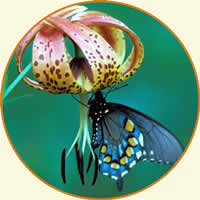USDA Forest Service Celebrating Wildflowers
|
|
|
Pollinator SyndromesPlants and pollinators have co-evolved physical characteristics that make them more likely to interact successfully. The plants benefit from attracting a particular type of pollinator to its flower, ensuring that its pollen will be carried to another flower of the same species and hopefully resulting in successful reproduction. The pollinator benefits from its adaptation to a particular flower type by ensuring that it will be able to find and access important food resources - nectar and pollen. Such relationships are considered mutualistic. Animals, wind, and water can all be vectors for pollen. The flower type, shape, color, odor, nectar, and structure vary by the type of pollinator that visits them. Such characteristics are considered pollination syndromes and can be used to predict the type of pollinator that will aid the flower in successful reproduction. Use the pollinator syndrome table to help you identify the potential pollinators you may associate with different flower types.
|
||||||||||||||||||||||||||||||||||||||||||||||||||||||||||||||||||||||||
| NOTE: PDF format links require the Adobe Acrobat Reader to view. | ||||||||||||||||||||||||||||||||||||||||||||||||||||||||||||||||||||||||
| top | Disclaimers | FOIA | Privacy Policy | Quality of Information | Photo Credits & Use | |||||||||||||||||||||||||||||||||||||||||||||||||||||||||||||||||||||||
Location: http://www.fs.fed.us/wildflowers/pollinators/syndromes.shtml
Last modified: Tuesday, 20-May-2008 15:56:20 EDT
